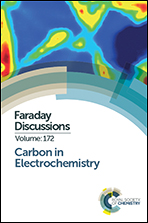Boron doped diamond biotechnology: from sensors to neurointerfaces
Abstract
Boron doped nanocrystalline diamond is known as a remarkable material for the fabrication of sensors, taking advantage of its biocompatibility, electrochemical properties, and stability. Sensors can be fabricated to directly probe physiological species from biofluids (e.g. blood or urine), as will be presented. In collaboration with electrophysiologists and biologists, the technology was adapted to enable structured diamond devices such as microelectrode arrays (MEAs), i.e. common electrophysiology tools, to probe neuronal activity distributed over large populations of neurons or embryonic organs. Specific MEAs can also be used to build neural prostheses or implants to compensate function losses due to lesions or degeneration of parts of the central nervous system, such as retinal implants, which exhibit real promise as biocompatible neuroprostheses for in vivo neuronal stimulations. New electrode geometries enable high performance electrodes to surpass more conventional materials for such applications.
- This article is part of the themed collection: Carbon in Electrochemistry

 Please wait while we load your content...
Please wait while we load your content...